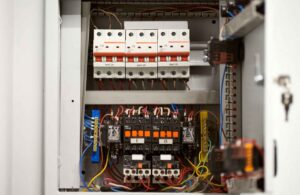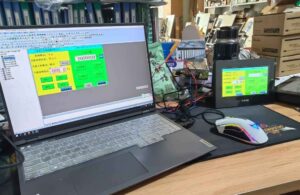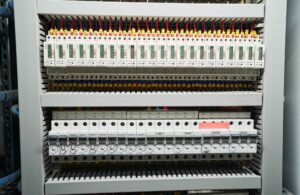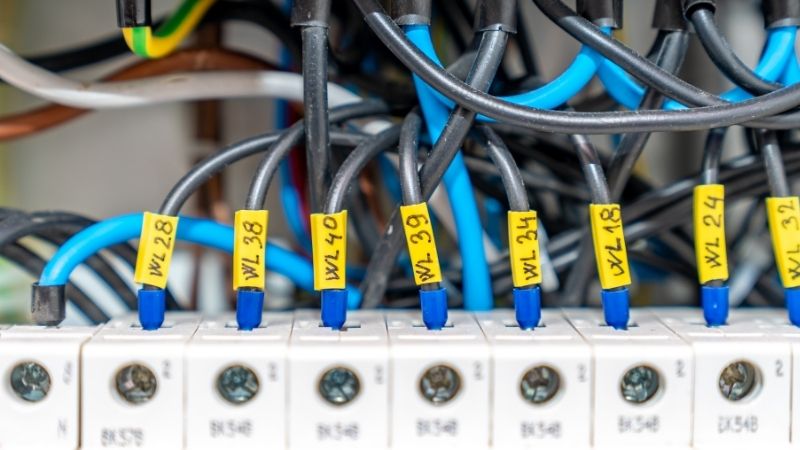Tipos de saída de PLC: guia essencial para engenheiros de automação
Seja você um profissional de automação experiente ou esteja apenas começando sua jornada, este artigo fornecerá insights valiosos sobre CLP tecnologias de saída.
Índice
Quais são os principais tipos de saídas de CLP e como elas funcionam?
Saídas PLC vêm em diversas variedades, cada uma projetada para aplicações e requisitos específicos. Os três tipos principais são:
- Saídas de relé: Dispositivos de comutação eletromecânicos tradicionais
- Saídas de Transistor: Comutação de estado sólido para aplicações DC
- Saídas Triac: Comutação de estado sólido para aplicações CA
As saídas de relé são as mais versáteis, pois podem lidar com cargas CA e CC. Um módulo de saída de relé típico contém bobinas físicas e contatos de relé, operados pela aplicação de tensão à bobina do relé. Por exemplo, o Allen-Bradley O 1756-OW16I tem 16 saídas de relé individuais, o que o torna adequado para diversas aplicações industriais.
Quais são as principais diferenças entre saídas de estado sólido e de relé?
A escolha entre saídas de estado sólido e de relé depende de vários fatores:
| Recurso | Saídas de estado sólido | Saídas de relé |
|---|---|---|
| Velocidade de comutação | Rápido (microssegundos) | Lento (milissegundos) |
| Vida útil | Longo (sem partes móveis) | Limitado (desgaste mecânico) |
| Faixa de voltagem | Limitado a CA ou CC | CA e CC |
| Custo | Custo inicial mais alto | Menor custo inicial |
| Manutenção | Mínimo | Manutenção regular necessária |
Uma vantagem das saídas de relé é sua independência de tensão, permitindo que elas comutem cargas CA e CC sem exigir módulos separados. No entanto, dispositivos de estado sólido oferecem melhor confiabilidade e vida útil mais longa devido à ausência de peças móveis.
Como os módulos de saída digital interagem com equipamentos industriais?
Módulos de saída digital servem como interface entre o programa PLC e dispositivos externos. Esses módulos podem controlar:
- Partidas de motor
- Válvulas solenóides
- Luzes indicadoras
- Contatores
- Outros dispositivos digitais ou discretos
O módulo de saída opera com base em decisões tomadas pelo programa PLC, convertendo essas decisões em ações físicas por meio de sinais de tensão ou corrente. Por exemplo, você pode usar uma saída para operar uma carga CA e outra saída para controlar uma carga CC, fornecendo opções de controle flexíveis.
Quais são as considerações importantes para a seleção de saída do PLC?
Ao selecionar saídas de PLC, considere estes fatores cruciais:
- Classificações de tensão e corrente
- Requisitos de tensão operacional
- Consumo máximo de corrente
- Necessidades de proteção contra surtos
- Requisitos de comutação
- Frequência de comutação
- Tipo de carga (resistiva, indutiva, capacitiva)
- Requisitos de tempo de resposta
- Condições ambientais
- Temperatura de operação
- Níveis de humidade
- Ruído elétrico
Quais são os problemas comuns de solução de problemas com saídas de CLP?
Entender problemas comuns de saída ajuda a manter a confiabilidade do sistema:
- Proteção contra curto-circuito de saídas
- Quedas de tensão em longas distâncias
- Interferência de equipamentos próximos
- Sintomas de falha do módulo de saída
- Técnicas de aterramento adequadas
Perguntas frequentes
Um módulo de saída PLC converte decisões de programa em ações físicas controlando dispositivos externos por meio de sinais elétricos.
A escolha depende dos seus requisitos de carga e do design do sistema. Saídas sinking são comuns na América do Norte, enquanto saídas sourcing são predominantes na Europa.
As saídas de transistor oferecem velocidades de comutação mais rápidas, maior vida útil e nenhum desgaste mecânico, tornando-as ideais para aplicações de alta velocidade.
Saídas de relé são preferidas quando é necessária flexibilidade de tensão ou quando é necessário isolamento elétrico completo entre os circuitos de controle e carga.
Use proteção adequada contra surtos, garanta a fiação correta, mantenha classificações de carga adequadas e implemente medidas de resfriamento adequadas.
Potencialize seus projetos com PLC Omron, Mitsubishi, Schneider novos e originais – em estoque, prontos agora!
Conclusão
- As saídas do PLC vêm em três tipos principais: relé, transistor e triac
- Cada tipo de saída tem vantagens e aplicações específicas
- A seleção adequada depende dos requisitos de carga e das condições ambientais
- Manutenção e monitoramento regulares garantem uma operação confiável
- Medidas de proteção são essenciais para a confiabilidade a longo prazo
Procurando por PLCs novos e originais para seus projetos? Na Kwoco, estocamos os PLCs mais recentes das principais marcas como Omron, Mitsubishi, e Schneider. Compre com confiança — envio rápido, qualidade garantida! Compre agora
Contate-nos
Basta preencher seu nome, endereço de e-mail e uma breve descrição de sua consulta neste formulário. Entraremos em contato com você em até 24 horas.
Você também pode achar esses tópicos interessantes

O que é um Painel de Controle Elétrico? Principais Insights Explicados
Um painel de controle elétrico é um componente crucial na automação industrial, servindo como o centro nervoso para controlar e monitorar vários dispositivos elétricos. Este artigo se aprofunda nos conceitos básicos de painéis de controle elétrico, seus componentes e sua importância para garantir operações eficientes e seguras em ambientes industriais.

O que é Programação de CLP? Um Tutorial Introdutório à Programação de CLP
Na produção comercial moderna, os programas CLP (Controlador Lógico Programável) tornaram-se uma das inovações essenciais em automação. Os CLPs são amplamente utilizados em sistemas de controle de automação industrial, e seu desempenho, confiabilidade e versatilidade substituíram com sucesso os sistemas de controle de relés tradicionais.

O que é um painel PLC? Um guia para automação elétrica
O painel de controle PLC é a pedra angular da automação industrial moderna, orquestrando processos complexos com precisão e eficiência. Entender o que é um painel PLC e como ele funciona é essencial para qualquer pessoa envolvida em operações industriais. Este guia abrangente iluminará o mundo dos controladores lógicos programáveis e seu papel fundamental na automação de processos industriais.






